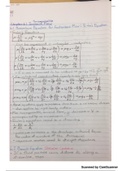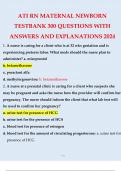Class notes
F214 Respiration
- Course
- Institution
Directly answers criteria from the specification. Easy to read. Easy to revise. All you need to know. Simple. Diagrams. Annotations.
[Show more]Some examples from this set of practice questions
1.
Describe the structure on an ATP molecule.
Answer: Adenosine Triphosphate. Nitrogenous base adenine, bonded to Carbon 1 on the Ribose sugar. Three phosphates bonded to Carbon 4.
2.
Give two reasons why plant/animal cells need to respire?
Answer: For transport methods Metabolic reactions Mitosis/Meiosis Replication of DNA, organelles Movement Activation of chemicals (phosphorylation of glucose)
3.
Give one coenzyme used in respiration, and how/why it is used.
Answer: Coenzyme A binds to acetate to feed it into the Krebs cycle. NAD is dehydrogenated to oxidise compounds. NADH is broken down for use in oxidative phosphorylation.
4.
What is the net total of products produced by glycolysis?
Answer: 2ATP, 2NADH, 2 Pyruvates
5.
What process causes Hexose 1-6 Bisphosphate to become Triose Phosphates?
Answer: Hydrolysis.
6.
How is the inner membrane adapted to maximise respiration?
Answer: Cristae allows larger surface area Different lipid composition causes it to be impermeable to small ions Many electron carrier proteins and ATP synthase enzymes High protein to phospholipid ratio - lots of proteins
7.
What causes pyruvates to become acetate in the link reaction?
Answer: Dehydrogenation by reducing NAD. Decarboxylation by releasing CO2.
8.
Where does the link reaction and Krebs cycle occur as opposed to glycolysis?
Answer: Glycolysis - cytoplasm of the cell. Link and Krebs - mitochondrial matrix.
9.
Citric Acid/Citrate is a 4 carbon compound. True or false?
Answer: False. It is a 6 carbon compound.

Stuvia customers have reviewed more than 700,000 summaries. This how you know that you are buying the best documents.

You can quickly pay through EFT, credit card or Stuvia-credit for the summaries. There is no membership needed.

Your fellow students write the study notes themselves, which is why the documents are always reliable and up-to-date. This ensures you quickly get to the core!
You get a PDF, available immediately after your purchase. The purchased document is accessible anytime, anywhere and indefinitely through your profile.
Our satisfaction guarantee ensures that you always find a study document that suits you well. You fill out a form, and our customer service team takes care of the rest.
Stuvia is a marketplace, so you are not buying this document from us, but from seller teepatel. Stuvia facilitates payment to the seller.
No, you only buy this summary for $3.91. You're not tied to anything after your purchase.
4.6 stars on Google & Trustpilot (+1000 reviews)
90830 documents were sold in the last 30 days
Founded in 2010, the go-to place to buy summaries for 14 years now

